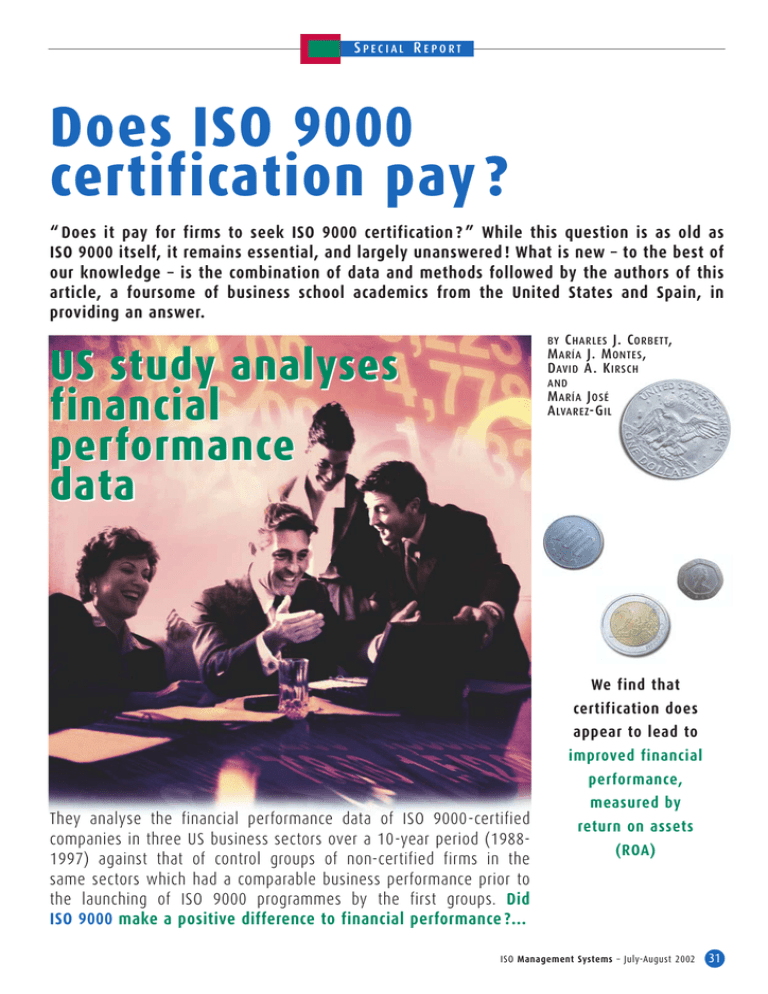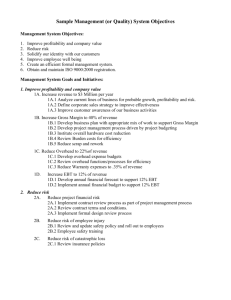Does ISO 9000 certification pay ?
advertisement

SPECIAL RE PORT Does ISO 9000 certification pay ? “ Does it pay for firms to seek ISO 9000 certification ? ” While this question is as old as ISO 9000 itself, it remains essential, and largely unanswered ! What is new – to the best of our knowledge – is the combination of data and methods followed by the authors of this article, a foursome of business school academics from the United States and Spain, in providing an answer. BY C HARLES J. C ORBETT, M ARÍA J. M ONTES , D AVID A. K IRSCH US study analyses financial performance data AND M ARÍA J OSÉ A LVAREZ-G IL We find that certification does appear to lead to improved financial performance, They analyse the financial performance data of ISO 9000-certified companies in three US business sectors over a 10-year period (19881997) against that of control groups of non-certified firms in the same sectors which had a comparable business performance prior to the launching of ISO 9000 programmes by the first groups. Did ISO 9000 make a positive difference to financial performance ?... measured by return on assets (ROA) ISO Management Systems – July-August 2002 31 SPECIAL RE PORT The authors Charles J. Corbett The Anderson School at UCLA, USA E-mail charles.corbett@ anderson.ucla.edu María J. Montes Universidad Carlos III, Madrid, Spain E-mail mmontes@emp.uc3m.es David A. Kirsch R.H. Smith School of Business, University of Maryland, USA E-mail dkirsch@rhsmith.umd.edu María José Alvarez-Gil Universidad Carlos III, Madrid, Spain E-mail catinaag@eco.uc3m.es 32 I mplementing a quality managelead to improved financial performment system and getting it certiance, measured by return on assets fied to one of the ISO 9000 stan(ROA). dards is not a piece of cake. While More precisely, we find that firms the actual costs involved differ from that failed to seek certification expecompany to company, the certifirienced substantial deteriorations in cation process inevitably requires ROA, productivity, and sales, while significant effort with respect to firms that did seek certification gendesigning, implementing and docuerally managed to avoid such menting appropriate processes, declines. In other words, firms that entailing both direct and indirect received certification did not, on costs associated with consulting and average, see their absolute performaudit fees, employee training, etc.. Is ance improve, but they did see their it worth it ? relative performance improve subSpecifically, how might investing stantially, compared to their uncertiin ISO 9000 certification pay off ? fied peers. Some argue that it How do we arrive leads to improved at this statement ? Firms that failed to seek internal processes, Below, we first which in turn enable describe our data certification higher productivity and methods, then experienced substantial and lower costs. we present and Others argue that discuss our findings deteriorations in ROA, customers increasin more depth. (See ingly require ISO Corbett et al. [2002] productivity, and sales, 9000, so certification for a more detailed while firms that did seek description of the should help maintain or increase a firm’s data and the methcertification generally market share. Yet ods followed.) managed to avoid others dispute these We used two benefits, claiming prime sources of such declines that the standard is information. Firstly, too generic to lead to Wo r l d P r e f e r r e d genuine improvements. In their view, (www.worldpreferred.com) kindly if any positive correlation is found shared with us their data on all between ISO 9000 certification and 21 482 ISO 9000 certifications awardfinancial performance, that merely ed in the US until 1998. These data reflects the fact that firms that are tell us the name and location of the better managed are also more likely site receiving certification, the date to seek ISO 9000 certification. Which of certification, and other informacamp is right ? tion not critical for our study. Surprisingly, no hard answer to Secondly, we used the Compustat this question has been given yet, database of financial information on despite the fact that the standards all publicly traded firms in the US, as have been around since 1987 and reported to the Securities and that over 500 000 certifications have Exchange Commission (SEC), from been awarded worldwide. Anecdotal 1988 to 1997. evidence abounds, both in favour of To measure the financial effect of and contradicting the hypothesis that ISO 9000 certification, we had to ISO 9000 somehow leads to merge these two datasets. For any improved financial performance. firm in our financial database, we In this article, we examine the had to be able to ascertain whether it effect of ISO 9000 certification on had ever received ISO 9000 certificapublicly traded firms in the US, and tion, and when. This matching proved find that certification does appear to to be anything but straightforward : ISO Management Systems – July-August 2002 SPECIAL RE PORT the two databases do not share any unique way of identifying firms or sites, so in the end, we had to resort to a variety of manual processes. Altogether, this effort took from 1999 to 2001, and yielded a database with 7 598 firms listed in Compustat which had received one or more ISO 9000 certificates prior to 1998. We focused on the three industrial sectors with the largest number of ISO 9000 certificates: SIC codes 28 (chemicals and allied products), 35 (industrial and commercial machinery and computer equipment) and 36 (electronic and other electrical equipment and components, except computer equipment). Table 1 contains a more detailed breakdown of our final sample. The final result for SIC 28 is a set of 74 firms receiving their first ISO 9000 certification by 1997; for SIC 35 and 36, our final sample includes 132 and 167 certified firms respectively. We used several performance measures. The main analysis focuses on financial performance, as measured by return on assets (ROA – operating income before depreciation divided by total assets). Another increasingly common measure is Tobin’s Q, which is the ratio of the market value of the outstanding financial claims on the firm to the current replacement cost of the firm’s assets, and measures the alternative-use value of the firm’s assets. Chung and Pruitt (1994) propose approximating Tobin’s Q by (MVE + PS + DEBT)/TA, where MVE is market value of equity, PS the liquidating value of the firm’s outstanding preferred stock, DEBT the value of the firm's short-term liabilities net of its short-term assets plus the book value of long-term debt, and TA the book value of total assets of the firm. Values of Tobin’s Q greater than 1 signify that the firm is extracting more value from its assets than would be obtained from selling them. We are also interested in knowing whether certification leads to inter- nal productivity improvements or external marketing improvements. To examine the effect on productivity, we compare whether firms’ costs of goods sold as a percentage of sales (COGS/SALES) improved after certification, i.e., decreased relative to the control group. To examine the marketing effect, we compare whether firms’ asset turnover, i.e., their sales divided by assets (SALES/ASSETS), increased after certification, relative to the control group. These measures are both closely related to ROA : improvements in productivity or in asset turnover should immediately lead to improvements in ROA. Table 1: Number of ISO 9000 certified firms in our sample, by year of first certification, in the three US industry sectors with the highest number of ISO 9000 certifications. SIC 28 SIC 35 SIC 36 1990 4 2 0 1991 2 5 6 1992 14 15 11 1993 16 25 35 1994 15 16 32 1995 13 27 34 1996 4 23 26 1997 6 19 23 Total 74 132 167 ISO Management Systems – July-August 2002 33 SPECIAL RE PORT Event study methodology We focused on the three industrial sectors with the largest number of ISO 9000 certificates 34 To examine the effect of ISO 9000 certification on performance, we followed the event-study methodology for detecting improvements in operating performance. In a nutshell, an event study compares performance of a group of firms that have undergone a particular event (in our case, their first ISO 9000 certification) with the performance of a comparable group of firms that did not undergo that event. This method is commonly used in financial research and has also been used to show that TQM (total quality management) improves firms’ performance (Hendricks and Singhal 1997). An event study requires specifying the event period, which in our case is the period during which ISO 9000 is implemented. A typical implementation takes anywhere from six to 18 months, so we define our event period as the year in which the first certification was received (call this year t) and the year immediately preceding certification (year t – 1). The period preceding the event period (year t – 2) is used for determining the control group. The years following the event period (years t + 1 through t + 3) are used to test whether certified firms experienced superior (or excess) performance compared to the control group. For example, if a company received certification in 1994, we use its performance in 1992 to select a control group, and then compare financial performance in all subsequent years, i.e. year t – 1 (or 1993), year t (or 1994), etc.. By choosing a control group of firms based on having comparable ISO Management Systems – July-August 2002 Explanation of charts The charts in Figures 1, 2, and 3 are included to summarize the findings in a succinct and graphic way. To construct these charts, we appended the incremental year-on-year changes in performance of the certified and non-certified firms. Strictly speaking, this is not correct, as the sample of certified firms changes as we consider longer horizons. The numbers referred to in the text are the true levels of superior performance of certified firms, given in the full paper ; they are largely consistent with, but not always exactly equal to those suggested by the charts. The charts are interpreted as follows. The continuous line shows performance of firms after receiving their first ISO 9000 certification, compared to a control group of firms shown by the dashed line. The certification was awarded in year t. The ROA chart shows that the control group is selected to have the same initial ROA in year t – 2 as the certified firm. The difference between the certified firms and the non-certified firms in, for instance, period t + 1 indicates the difference in performance achieved by certified firms in the year following certification, relative to their control group, averaged across all certified firms. For the three other performance measures (Tobin’s Q, COGS/SALES, and SALES/ASSETS), we have artificially let the control groups start at the same point as the certified firms, to highlight the differences in performance after certification and to facilitate comparison with the ROA chart. SPECIAL RE PORT Figure 1: ISO 9000 certification in the chemical industry (SIC 28) Certified Non-certified characteristics before the event, i.e., before receiving ISO 9000 certification, an event study allows us to test whether firms that receive ISO 9000 certification achieve higher performance than otherwise comparable firms that did not receive certification. Results Chemicals The results for each of the three industries are shown in Figures 1, 2 and 3 respectively – see the box, “ Explanation of charts ” on page 26. The top chart in Figure 1 compares ROA of certified and non-certified firms in the chemical industry (SIC code 28). The figure shows that, on average 1) , non-certified firms saw their ROA drop, while the ROA of the firms undergoing certification was fairly constant. A firm starting with an ROA of 17,9 % (the average of certified firms in SIC 28 in year t – 2) would, on average, see its ROA stay more or less constant in the year prior to certification, while non-certified firms saw a drop. The difference between the two groups was 0,9 percentage points, a relative difference in ROA of 5,0 %. By year t + 3, the certified firm would have seen the gap in ROA increase to 2,1 percentage points, a relative difference of 12 %. Moving to Tobin’s Q, in the second chart in Figure 1, we find a largely similar pattern, though the effect does not materialize until a year 1) The results presented here are all based on median excess performance; the median is defined such that half of all observations are larger than the median, and half are smaller. Medians are often preferred over means as they are less sensitive to outliers. ISO Management Systems – July-August 2002 35 SPECIAL RE PORT Figure 2: ISO 9000 certification in the industrial machinery and computer industry (SIC 35) Certified Non-certified later, during the year of certification. By year t + 3, Tobin’s Q of certified firms was 0,45 higher than that of non-certified firms, a relative difference of 29 % compared to the starting value of 1,5. What drives the improvement in ROA ? Immediately after deciding to seek certification, firms experience a productivity improvement, while noncertified firms see no such improvement and eventually experience a gradual productivity decline, as witnessed by the drop in COGS/SALES in the third chart in Figure 1. The gap grows as the horizon increases. Certified firms on average experience COGS/SALES ratios of 1,5 percentage points lower than non-certified firms by year t + 3, a relative difference of 2,7 %. The bottom chart in Figure 1 shows that certified firms have a slightly smaller decline in SALES/ ASSETS in the first two years after certification than non-certified firms, though in the longer term, this effect does not appear to be statistically significant. Summarizing the findings for SIC 28, it is clear that firms’ first ISO 9000 certification did lead to relative improvements in ROA, primarily through increased productivity. Industrial machinery and computers Turning to the industrial machinery and computer industry (SIC code 35), the effects on ROA follow a similar pattern but are magnified. Certified firms again avoid the significant drop in ROA experienced by non-certified firms, and these relative improvements persist over time. 36 ISO Management Systems – July-August 2002 SPECIAL RE PORT Figure 3: ISO 9000 certification in the electronic equipment and components industry (SIC 36) Certified Non-certified By year t + 3, certified firms have an ROA of 4,8 percentage points higher than non-certified firms, a relative difference of 37 %. Interestingly, we do not find a correspondingly strong effect on Tobin’s Q here. Non-certified firms experience substantial loss of productivity and sales compared to certified firms. By year t + 3, SALES/ASSETS of certified firms is 9,9 percentage points higher than that of non-certified firms, a relative difference of 7,6 %. Summarizing, firms in SIC 35 also experienced significant improvements in ROA, driven in part by sales and in part by relative reductions in costs. Electronics and electrical equipment Similarly, non-certified firms in the electronics and electrical equipment sector (SIC code 36) display a large drop in ROA, while certified firms keep ROA more or less constant. By year t + 3, the difference is 8,7 percentage points, a relative difference of 55 % compared to year t – 2. These relative improvements in ROA are translated into significant differences in Tobin’s Q. By year t + 3, the difference has grown to 0,24, a 15 % increase. Firms in SIC 36 keep productivity constant, while non-certified firms experience substantial cost increases. By year t + 3, COGS/SALES of certified firms is 2,9 percentage points lower than for non-certified firms, a relative difference of 4,9 %. Overall, they also experience a much smaller decline in SALES/ASSETS than non-certified firms; further analysis reveals that this is especially true for firms that adopt early. ISO Management Systems – July-August 2002 37 SPECIAL RE PORT In more detailed analyses still underway, some of these effects appear to be stronger for firms that received multiple certifications by 1997 than for firms that received one single certification, and are also often stronger for firms that were certified early rather than late. Control groups in event study research A key paper on event study methods is Barber and Lyon (1996) who find that the control group should be matched to the certified firms based on pre-event performance. If one fails to do so, finding that ISO 9000 certified firms experience higher post-certification performance may simply reflect that these firms already had superior pre-certification performance. By selecting a performance-matched control group, a positive performance difference is more likely to reflect an underlying causality rather than a common cause. Our results suggest that failing to seek ISO 9000 certification contributes to gradually worsening performance 38 Summarizing, firms in SIC 36 experience significant cost reductions and sales benefits from certification, resulting in clear improvements in ROA and Tobin’s Q. Combining results from all three SIC codes, we conclude that firms that decided to seek ISO 9000 maintained their ROA in all three industries, while the non-certified firms saw their performance decline over time. In the chemical industry, the effects are primarily internal : ISO 9000 leads to cost reductions through improved productivity. In the industrial and commercial machinery, computer equipment, electronic and other electrical equipment and components industries, both sales and cost effects are observed. ISO Management Systems – July-August 2002 This means that expected performance Pi,t+l of firm i in any period t +l (where period t is the year of certification) is given by E[Pi,t+l] = Pi,t–2 + (PIi,t+l – PIi,t–2), where PIi,t denotes the performance of firm i’s control group. Excess (or “ abnormal ”) performance is the certified firm’s performance relative to the benchmark defined by the control group, i.e., APi,t+l = Pi,t+l – E[Pi,t+l]. Following Barber and Lyon’s recommendation, we match each certified firm with a control group of non-certified firms in the same industry (at the 2-digit SIC code level) with ROA in the year t – 2 between 90 % and 110 % of the certified firm’s ROA. SPECIAL RE PORT References Barber, B.M. and J.D. Lyon. 1996. Detecting Abnormal Operating Performance : The Empirical Power and Specification of Test Statistics. Journal of Financial Economics 41 359-399. Chung, K.H. and S.W. Pruitt. 1994. A Simple Approximation of Tobin’s Q. Financial Management 23(3) 70-74. changes that, directly or indirectly, led to relative improvements in ROA, both through superior cost control and higher sales. Are these improvements a direct causal effect of deciding to seek ISO 9000 ? Certainly, it is possible that the decision to seek ISO 9000 is positively associated with other “ good management ” practices, and that it is these latter practices that improve ROA Corbett, C.J. 2002. Diffusion of ISO 9000 and ISO 14000 Through Global Supply Chains. Manuscript, UCLA. Available at http://personal.anderson.ucla. edu/charles.corbett/research.htm. Corbett, C.J., M.J. Montes and D.A. Kirsch. 2002. The Financial Impact of ISO 9000 in the US : An Empirical Analysis. Manuscript, UCLA. Available from October 2002 at http://personal.anderson.ucla. edu/charles.corbett/research.htm. Hendricks, K.B. and V.R. Singhal. 1997. Does Implementing an Effective TQM Program Actually Improve Operating Performance ? Empirical Evidence from Firms That Have Won Quality Awards. Management Science 43(9) 1258-1274. Interpreting the results How should one interpret these results ? Strictly speaking, they show that “ firms experience significantly better performance after deciding to seek their first ISO 9000 certification, than a control group of firms with similar performance prior to that decision ”. This strongly suggests that, after deciding to seek their first ISO 9000 certification, firms have made rather than the ISO 9000 implementation and certification process itself. However, the control groups consist of firms with the same ROA prior to the certification decision, so something changed specifically at the certified firms in the year prior to the actual certification. ISO Management Systems – July-August 2002 39 SPECIAL RE PORT After deciding to seek their first ISO 9000 certification, firms have made changes that, directly or indirectly, led to relative improvements in ROA, both through superior cost control and higher sales 40 Given the magnitude of the performance improvements, it seems likely that other effects than ISO 9000 certification contributed. However, due to the use of performancematched control groups and the persistent nature of the relative improvements, our findings do strongly suggest that the preparations for the first ISO 9000 certification also contributed to superior performance. The good news, clearly, is that, in all analyses we conducted, we found significant relative improvements in ROA. From that perspective, we can answer the original question of, “ Does it pay to seek ISO 9000 certification ?” with a resounding “ YES !” (though, as true academics, we should immediately qualify this with several caveats, discussed in the full paper). Interestingly, though, it seems as if ISO 9000 certification is more often a necessary condition to maintain current performance rather than a sure-fire way to improve performance. This is also quite plausible: given that ISO 9000 is a public standard, it is difficult to envisage how any one firm would be able to gain sustainable competitive advantage from it. For that, a firm must have other, deeper resources, that are harder to imitate. However, our results suggest that failing to seek ISO 9000 certification contributes to gradually worsening performance. By using ROA as our performance measure, we deliberately take a wide range of costs and benefits into account, including those that are indirect or difficult to quantify, and hence are normally excluded from any narrow cost-benefit analysis of whether to seek certification. The fact that certification led to relative improvements in ROA does not necessarily translate into specific improvements that can be predicted and captured in such a cost-benefit analysis. This is exacerbated by the fact that the performance improvements are not absolute but relative, and ISO Management Systems – July-August 2002 contribute to maintaining, rather than improving financial performance. Altogether, this leads us to a seemingly contradictory conclusion : the decision to seek ISO 9000 certification did lead to substantial performance improvements, but is difficult to justify in advance using a traditional cost-benefit analysis, implying that it has to be based, to some extent, on faith. Acknowledgements The authors are grateful to WorldPreferred (www.worldpreferred.com), the Canadian company which maintains an international database of organizations certified to management system standards, for sharing their data on ISO 9000 certifications in North America, and to Marvin Lieberman, Raghavendra Rau, and Lena Sernova for their helpful suggestions. Part of this work was performed while the second author was Visiting Scholar and the third author was Visiting Professor at the Anderson School at UCLA, University of California, Los Angeles, USA. We are grateful for financial support from the University of California Pacific Rim Research Program and from the Harold Price Center for Entrepreneurial Studies. The first author received funding from ISO Central Secretariat for a different study on global diffusion of ISO 9000 and ISO 14000.






